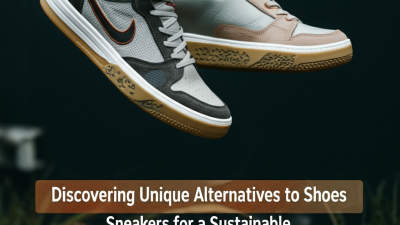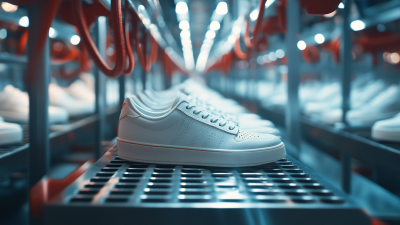
 As the fashion industry increasingly shifts towards sustainability, the footwear sector is facing a pivotal moment to innovate and adapt. Traditional "shoes sneakers," while popular, often rely on materials and manufacturing processes that detract from environmental well-being. According to a report by the Global Fashion Agenda, the footwear sector is responsible for approximately 1.4% of global greenhouse gas emissions, prompting a demand for sustainable alternatives. With consumers becoming more aware of the environmental impact of their purchases—93% of millennials are willing to pay more for sustainable products—it is crucial for brands to explore unique alternatives that minimize their carbon footprint. This blog will delve into various sustainable footwear options, emphasizing the significance of choosing eco-friendly "shoes sneakers" that can pave the way for a greener future in fashion.
As the fashion industry increasingly shifts towards sustainability, the footwear sector is facing a pivotal moment to innovate and adapt. Traditional "shoes sneakers," while popular, often rely on materials and manufacturing processes that detract from environmental well-being. According to a report by the Global Fashion Agenda, the footwear sector is responsible for approximately 1.4% of global greenhouse gas emissions, prompting a demand for sustainable alternatives. With consumers becoming more aware of the environmental impact of their purchases—93% of millennials are willing to pay more for sustainable products—it is crucial for brands to explore unique alternatives that minimize their carbon footprint. This blog will delve into various sustainable footwear options, emphasizing the significance of choosing eco-friendly "shoes sneakers" that can pave the way for a greener future in fashion.
The footwear industry is undergoing a significant transformation as consumers increasingly seek eco-friendly alternatives to traditional sneakers. With over 300 million pairs of sneakers sold annually in the U.S. alone, the environmental impact is substantial. Reports indicate that sneaker production generates approximately 14 million tons of carbon emissions each year. This situation has led innovative designers to explore alternative materials that not only reduce environmental footprints but also provide unique aesthetics.
Materials like mushroom leather, algae-based foams, and recycled plastics are gaining traction in the market. A study by the Ellen MacArthur Foundation suggests that using recycled materials could reduce global footwear plastic waste by 30% by 2030. For those looking to switch to sustainable options, consider brands that utilize biodegradable materials or those implementing circular production processes. One effective tip is to research and invest in brands that prioritize transparency in sourcing, ensuring that you support ethical practices in the industry.
Additionally, exploring local artisans who incorporate sustainable practices into their designs can enhance your wardrobe while supporting small businesses. Finding unique footwear that minimizes environmental impact is easier than ever, thanks to the rise of eco-conscious designers. By making informed choices, you can contribute to a more sustainable future for footwear while enjoying styles that stand out.
| Material | Sustainability Feature | Environmental Impact | Biodegradability |
|---|---|---|---|
| Bamboo | Rapid growth rate | Low carbon footprint | Yes |
| Recycled PET | Made from recycled plastic bottles | Reduces waste | Partial |
| Organic Cotton | No pesticides used | Helps preserve soil | Yes |
| Natural Rubber | Sustainable sourcing | Biodegradable | Yes |
| Hemp | Low environmental impact | Soil enrichment | Yes |
As the global demand for sustainable footwear continues to rise, innovative brands are stepping up to offer
unique alternatives to conventional sneakers and shoes. These alternatives not only prioritize the environment but also challenge traditional perceptions of
style and functionality. With a projected growth in the global children's footwear market from $500.83 billion in 2025
to $863.2 billion by 2032, it’s clear that parents are looking for eco-friendly options for their kids.
These brands are creating shoes using sustainable materials, like bio-based plastics and recycled fabrics, ensuring that style does not come at the expense of
the planet.
Additionally, the artificial leather market reflects this shift in consumer behavior. It is expected
to grow from $37.59 billion in 2025 to $57.94 billion by 2032, with a compound
annual growth rate of 6.38%. This growth is driven by a strong demand for animal-friendly products, offering stylish and
durable footwear alternatives without the ethical concerns associated with traditional leather. As consumers become increasingly aware of the need for sustainable
options, brands are rising to the occasion, crafting footwear that honors both the planet and personal style.
The rise of ethical consumerism has sparked a growing interest in vegan and traditional leather alternatives in the sneaker industry. According to a recent report by the Global Footwear Market, the demand for sustainable footwear is projected to reach $200 billion by 2027, with vegan options gaining a significant share of this market. Vegan sneakers, made from materials such as recycled plastics, organic cotton, and plant-based leathers, offer a cruelty-free alternative that is appealing to environmentally conscious consumers. In addition to reducing animal harm, vegan materials often have a lower carbon footprint than traditional leather, which involves extensive resources and contributes to deforestation.
When considering the choice between vegan and traditional leather sneakers, it is crucial to analyze not just the material but also the manufacturing process. Traditional leather production can emit substantial greenhouse gases, with estimates suggesting that producing one pair generates as much as 25 kg of CO2. On the other hand, some vegan alternatives use synthetic materials that may also raise environmental concerns, particularly regarding microplastics. Therefore, opting for products certified by organizations such as the Global Organic Textile Standard (GOTS) can provide consumers with assurance about their environmental impact.
Tips for Choosing Sustainable Sneakers:
The rise of minimalist footwear marks a significant shift towards sustainability in the footwear industry. According to a study by the Fashion Institute of Technology, the global demand for sustainable products has surged, with nearly 66% of consumers expressing a preference for brands that focus on eco-friendly practices. Minimalist shoes, which emphasize simplicity and natural materials, align perfectly with this growing trend, offering an alternative that reduces unnecessary waste and energy consumption.
Moreover, the minimalist footwear movement supports a healthier lifestyle, promoting better foot mechanics and overall well-being. Research from the University of Southern California indicates that minimalist shoes can lead to improved balance and strength in the feet, encouraging consumers to adopt a more active lifestyle. As the industry reevaluates its environmental impact, minimalist designs often utilize sustainable materials such as organic cotton and recycled rubber, further reducing their carbon footprint. This shift not only benefits individual health but also contributes to a broader, greener future for our planet.
In the quest for sustainable footwear, exploring the lifetime impact of various shoe options reveals significant insights. Surprisingly, while eco-sneakers are increasingly marketed as a greener choice, data indicates that they typically reduce emissions by less than 10%. In fact, a mere 1 in 29 pairs of sneakers available on the market qualify as eco-sneakers, highlighting the need for greater clarity and authenticity in sustainability claims.
The NNormal Tomir 02 serves as a case study in this landscape; despite not using recycled materials or possessing Bluesign-approved components, it offers extensive repair services. This highlights a critical aspect of sustainability: the potential for longevity and repairability can outweigh the initial manufacturing choices. Furthermore, the insights gathered from a Life Cycle Assessment of polyester garments unveil the environmental burdens associated with fabric production, urging the fashion industry to rethink its entire supply chain. The integration of circular economy principles, particularly the recycling of end-of-life fishing nets and materials, has the potential to mitigate some of these impacts, marking a significant step toward a more sustainable future in footwear.






